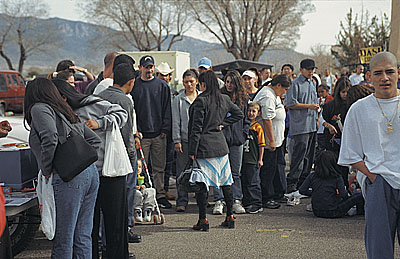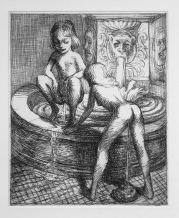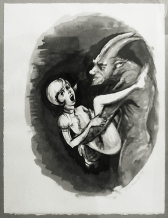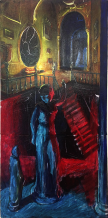| Umělec magazine 2003/3 >> Units of Speakers Threaten the Peace | List of all editions. | ||||||||||||
|
|||||||||||||
Units of Speakers Threaten the PeaceUmělec magazine 2003/301.03.2003 Ivan Mečl | profile | en cs |
|||||||||||||
|
“And by Wednesday I’ve got to have everything ready. But now if I think about it, there’s still a chance to postpone it, yeah, that would be good, because then I could get done what I haven’t done yet, but then again it’s not like it can wait, and what’s got to get done gets done. But then, what if I just don’t even do it? Anyway, nothing would even happen if I never even did it. Maybe what would happen is that I would rethink doing things. Maybe then it’s better to do nothing at all. Then on Tuesday I wouldn’t have to pick it up here and on Monday we wouldn’t have to get all the stuff ready for the pick up, yeah that’s right. Well, then if I never even bothered with this matter, then I could do something that I really wanted to do.”
The first Speakers were little motionless dolls, which still managed to kick up a lot of good cheer among gallery visitors. These faceless child-like figures with their prattling voices imitating intellectuals, stoners and office managers became extremely popular. But this was certainly the last thing their creator, Kryštof Kintera, wanted from them. So it became necessary to set the Speakers in motion and send them out to be among people. Why build complicated steel androids when intelligent pieces of meat serve just as well. That meat is called Jednotka (Unit), a group of actors and artists who do not perform in Unit under their own names. How are living Speakers made? Not everyone can become a Speaker, and a person is only a Speaker for a short time. You see, a Speaker is the spiritual and, at the same time, mechanical superstructure of a human being. To acquire this gift it requires a lot of time spent in individual and group concentration on naked mental and creative psychic work. First the Speakers prepare themselves. In the privacy of home or at a friend’s. They relax and close their eyes or stare with crazed spastic eyes at the sidewalk. And then they speak. They have to verbalize absolutely everything that pops into their heads, while paying attention to the communication and ideas of the posture they are impersonating. In his mind he meets pedestrians, and he chooses to speak to some of them, like he wants to tell them everything he can think of. What would a mentally tormented queen like to convey? What would she like to say to almost everyone she meets? What words would come streaming from that good- natured fatty, who is a pathological glutton? What pops into the mind of the sullen and furious manager on his way to work. All of this the biological component of the Speaker records before he enters into the collective seance. While in the seance, as a group, they listen to the testimonies and make collective corrections. The Unit must come to an agreement. They must be certain as a group and as individuals. Now all that’s left is to modulate the edited recording with intonation. The real Speaker, that is, the one who is actually speaking is the technical equipment carried by biological carrier. It weighs up to several dozen kilos, and once turned on operates independently of the muscled being. On the other hand, while in action the human can adjust to the best of his ability to the statements of the technological speaker and the reactions of the environment. Sometimes it happens that the biological carrier of the Speaker is trounced by the reactions of the environment. The advantage of the Speaker is its indestructibility. It continues working and speaking even after the biological death of the carrier. Even if he or she is handcuffed, beaten and smacked on the hood of a police car, the endless, unchanging drivel with its urgent intonation drones on. You might say that a dead Speaker is still a Speaker, even if it no longer looks so good. The existence of the Speaker ends when the batteries die. The strategy of Speakers for the group Unit is clear: the mucking up of the social life in various public places in different cities. Communication in the social life of European cities apparently consists of oblivious and gloomy people walking around without any interest in their animate or inanimate surroundings. Such individuals, of course, react to any disturbance in the surroundings with a verbal attack, a sulky retreat or a knowingly ironic grimace. Inside, however, these people are actually jolly ol’ fellows, slyboots, or sometimes spiteful bastards that notice every move of the people passing them by, people sitting in the park, and they follow along after them with their many awkward thoughts. Among them you will find many unconsciously engaged philosophers and priests. They are only afraid to speak up. Their brains contains all of human knowledge, but while in public they only repeat half-remembered utterances from TV or the radio. Not so with Speakers. The Speaker is the conscience of the passer-by. The speaker vocalizes the thoughts of the passers-by. That is its purpose. A Speaker simply speaks its mind, for all to hear. The power of the group Unit lies in its heterogeneity. This impressive performance is put together from flashes of consciousness, fragments of sentences, contorted facial expressions and movements. The human carrier doesn’t speak at all, only makes faces, usually so successfully that even if the Speaker — machine — falls silent, the person would still stick out. He looks into the faces of those around him in the streets and flirtatiously smokes a cigarette, acts like a savior, and makes incredibly angry faces. He gorges himself on a bag full of food or lies down on the pavement. He is bitter among all these people and his thoughts crawl under their coats and into their pants. A few spectators laugh. He is confused. When the attack comes, it appears to be unorganized. The first feeling the spectator has — there’s something a little bit off in my surroundings. Something’s different from my usual wait here for the tram. A mental monologue creeps up in his thoughts. Gadzooks, it’s as if I’m thinking out loud. And similar desperate analogies. But there’s no one speaking. It’s coming from that hardboiled yuppie standing next to me. “I’m really sweating here. And I think there’s more in my right armpit than in my left. This is strange, this. Or maybe it’s just the same thing, to say. I’m just sweaty. Don’t know why this is. I feel just fine, ok, this is. I’m sweating, only. I don’t know if all people sweat like this. Mmm, yes, it’s normal, I think, everybody sweats.” And there comes that slut with the big tits. Smokes like she’s in a bar and acts like a homegrown porno star: “Hey, do you suffer? I mean, like, do you suffer in life. Like, if you feel sick. I feel sick. Like, I’m really bad off, I feel sick, I have no money, no flat, nowhere to go, I have no... and you have friends? Do you have friends? Or a girlfriend? A boyfriend? One? Or at least a teacher? I don’t even have a teacher. I used to have a teacher, but he’s gone.... I’m so bad off that I need some help. Eh... do you need help? We could help each other.... like, if you’re as bad off as me, then I could help you and you could help me, or you could help me, me, I feel so bad that I can’t see who you are.” And that fatty! Sausage in one hand, can of beer in the other. God, he eats nonstop. He can’t even breathe. His eyes are popping out of his head. And he’s going on about how to live a harmonious and happy life. “Everyone be happy and eat.” He’s so fat, and he doesn’t mind. No one has to mind. Just thinking about food. The Roma have the most fun with Speakers. They are amused that they behave in the street just like they do. The Roma solve all their problems out loud in the open and everywhere. And so do the Whites who have fallen out of their standard roles. Who is that guy speaking to nobody in the tram or addressing others with seemingly illogical questions? Drunkards, lunatics, the smallest kids and the oldest pensioners. But who is best off? Of course those who know the meaning of their words, their message and the value of the scattered pearls they toss. The non-speakers. “Here we go over there and over there, well, and... you’re just hanging around here. And this is begging, is it? You think that it’s possible to do this here, just like that, to lie around, like, here? So I lay down, just like you there. So what do you think about that, huh? You’d like it, wouldn’t you, if I was just hanging here like this all the time. Sure you’d like it! And how would they like it, huh? Well, how would they like it? I’d say let’s join them, we’ll join them. All of us. We’ll go to the zoo, like.
01.03.2003
Recommended articles
|
|||||||||||||
|
04.02.2020 10:17
Letošní 50. ročník Art Basel přilákal celkem 93 000 návštěvníků a sběratelů z 80 zemí světa. 290 prémiových galerií představilo umělecká díla od počátku 20. století až po současnost. Hlavní sektor přehlídky, tradičně v prvním patře výstavního prostoru, představil 232 předních galerií z celého světa nabízející umění nejvyšší kvality. Veletrh ukázal vzestupný trend prodeje prostřednictvím galerií jak soukromým sbírkám, tak i institucím. Kromě hlavního veletrhu stály za návštěvu i ty přidružené: Volta, Liste a Photo Basel, k tomu doprovodné programy a výstavy v místních institucích, které kvalitou daleko přesahují hranice města tj. Kunsthalle Basel, Kunstmuseum, Tinguely muzeum nebo Fondation Beyeler.
|

































 New book by I.M.Jirous in English at our online bookshop.
New book by I.M.Jirous in English at our online bookshop.
Comments
There are currently no comments.Add new comment